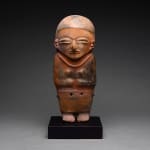Bahia Terracotta Sculpture of a Woman, 200 BCE - 600 CE
Terracotta
10.2 x 25.4 cm
4 x 10 in
4 x 10 in
CK.0026
Further images
The Pre-Columbian cultures of Ecuador are among the oldest in South America and among the first to master the art of pottery. Although we know little about the peoples themselves...
The Pre-Columbian cultures of Ecuador are among the oldest in South America and among the first to master the art of pottery. Although we know little about the peoples themselves or their traditions, historians have been able to piece together a picture of life in Ancient Ecuador thanks in part to the art and artifacts left behind. The culture of Valdivia created some of the oldest known works of art in the Americas. Situated along the coastal strip of Ecuador, the Valdivians established a thriving society that flourished for around two thousand years (from approximately 4000 to 1500 B.C.). Today they are famed for their small fertility figures, believed to be the earliest representational works of art in the Americas, first carved from stone, later formed from terracotta.
Hundreds of years later after the Valdivians disappear from the archaeological record appears another culture to which the name Chorrera has been attached (lasting from circa 1100-300 B.C.). Little is known about this culture; however, it is significant for its widespread geographical reach. As such, their artistic style greatly influenced those diverse cultures that began to emerge in the final centuries of the Chorrera period, a time historians have labeled the Period of Regional Development.
Among the most prominent cultures that flourished in the wake of the Chorrera are the cultures of Bahia, Jama Coaque, and La Tolita. Around 200 B.C., the Bahia developed along the coastal strip in the modern province of Manabi, lasting until approximately 600 A.D. Their earliest terracotta works were greatly indebted to the Chorrera; however, over the years a distinctive style emerged characterized by large figures adorned with detailed dress and body ornamentation.
This charming sculpture depicts a woman standing with her arms folded over her stomach, just below her breasts. She wears a long skirt, painted yellow, from which her feet stick out at the bottom. Either a necklace or the collar of the dark garment that covers her upper body echoes the curve of her chin. Her face is painted yellow with some white highlights and her facial features are characteristic of the Bahia style in particular and art produced around this time period in the province of Manabi in general. Stiff and somber, such a work likely had ceremonial significant for the ancients, and its power still reverberates today.
Hundreds of years later after the Valdivians disappear from the archaeological record appears another culture to which the name Chorrera has been attached (lasting from circa 1100-300 B.C.). Little is known about this culture; however, it is significant for its widespread geographical reach. As such, their artistic style greatly influenced those diverse cultures that began to emerge in the final centuries of the Chorrera period, a time historians have labeled the Period of Regional Development.
Among the most prominent cultures that flourished in the wake of the Chorrera are the cultures of Bahia, Jama Coaque, and La Tolita. Around 200 B.C., the Bahia developed along the coastal strip in the modern province of Manabi, lasting until approximately 600 A.D. Their earliest terracotta works were greatly indebted to the Chorrera; however, over the years a distinctive style emerged characterized by large figures adorned with detailed dress and body ornamentation.
This charming sculpture depicts a woman standing with her arms folded over her stomach, just below her breasts. She wears a long skirt, painted yellow, from which her feet stick out at the bottom. Either a necklace or the collar of the dark garment that covers her upper body echoes the curve of her chin. Her face is painted yellow with some white highlights and her facial features are characteristic of the Bahia style in particular and art produced around this time period in the province of Manabi in general. Stiff and somber, such a work likely had ceremonial significant for the ancients, and its power still reverberates today.







